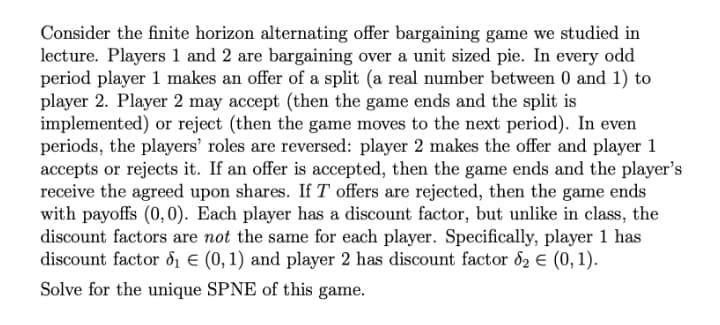Consider the finite horizon alternating offer bargaining game we studied in lecture. Players 1 and 2 are bargaining over a unit sized pie. In every odd period player 1 makes an offer of a split (a real number between 0 and 1) to player 2. Player 2 may accept (then the game ends and the split is implemented) or reject (then the game moves to the next period). In even periods, the players' roles are reversed: player 2 makes the offer and player accepts or rejects it. If an offer is accepted, then the game ends and the play receive the agreed upon shares. If T offers are rejected, then the game ends with payoffs (0, 0). Each player has a discount factor, but unlike in class, th discount factors are not the same for each player. Specifically, player 1 has discount factor d1 € (0,1) and player 2 has discount factor d2 E (0, 1). Solve for the unique SPNE of this game.
Consider the finite horizon alternating offer bargaining game we studied in lecture. Players 1 and 2 are bargaining over a unit sized pie. In every odd period player 1 makes an offer of a split (a real number between 0 and 1) to player 2. Player 2 may accept (then the game ends and the split is implemented) or reject (then the game moves to the next period). In even periods, the players' roles are reversed: player 2 makes the offer and player accepts or rejects it. If an offer is accepted, then the game ends and the play receive the agreed upon shares. If T offers are rejected, then the game ends with payoffs (0, 0). Each player has a discount factor, but unlike in class, th discount factors are not the same for each player. Specifically, player 1 has discount factor d1 € (0,1) and player 2 has discount factor d2 E (0, 1). Solve for the unique SPNE of this game.
Chapter8: Game Theory
Section: Chapter Questions
Problem 8.8P
Related questions
Question

Transcribed Image Text:Consider the finite horizon alternating offer bargaining game we studied in
lecture. Players 1 and 2 are bargaining over a unit sized pie. In every odd
period player 1 makes an offer of a split (a real number between 0 and 1) to
player 2. Player 2 may accept (then the game ends and the split is
implemented) or reject (then the game moves to the next period). In even
periods, the players' roles are reversed: player 2 makes the offer and player 1
accepts or rejects it. If an offer is accepted, then the game ends and the player's
receive the agreed upon shares. If T offers are rejected, then the game ends
with payoffs (0,0). Each player has a discount factor, but unlike in class, the
discount factors are not the same for each player. Specifically, player 1 has
discount factor d1 E (0, 1) and player 2 has discount factor d2 € (0, 1).
Solve for the unique SPNE of this game.
Expert Solution
This question has been solved!
Explore an expertly crafted, step-by-step solution for a thorough understanding of key concepts.
This is a popular solution!
Trending now
This is a popular solution!
Step by step
Solved in 2 steps

Knowledge Booster
Learn more about
Need a deep-dive on the concept behind this application? Look no further. Learn more about this topic, economics and related others by exploring similar questions and additional content below.Recommended textbooks for you

